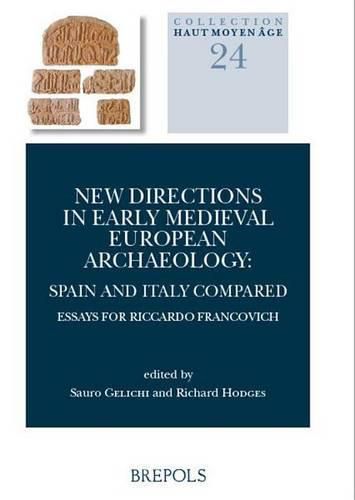Readings Newsletter
Become a Readings Member to make your shopping experience even easier.
Sign in or sign up for free!
You’re not far away from qualifying for FREE standard shipping within Australia
You’ve qualified for FREE standard shipping within Australia
The cart is loading…






On 30 March 2007 Riccardo Francovich died suddenly and Europe lost one of its greatest archaeologists. The impact of Francovich’s teaching had on the birth and development of medieval archaeology has been very strong, especially in the country where he worked (Italy), and on the archaeologists of his ‘adopted’ country, namely Spain. If medieval archaeology has grown over the last thirty years in these two countries, it is certainly thanks to him. For this reason, on 11 June, 2011, some of his closest colleagues and family gathered in Rome at the British School of Rome, in order to remember him and to open a serious discussion on issues that were central to his interests as well as those pertinent to any understanding Italian and Spanish historiography in the second half of the 20th century. Discussing together on this occasion in Rome, there emerged perspectives of analysis, interpretative paradigms and models of reading the original, that recent research has strongly renewed and that often possessed a shared commonality. All this showed that, even with the obvious differences of the national ‘stories’, not only might one recognize similar conjunctures (the impact of new ‘barbarian’ aristocracies on the social structures of the Roman world, the modalities of Islamization, for example), but also find parallel evolutions in terms of macrostructures (in the lives of urban and rural communities, for example). Hence the idea of comparing two different worldviews after the end of antiquity, through the identification of specific topics, made possible by archaeological research that had developed with great effect (and with good results) in recent decades . The optical analysis of these processes is essentially an archaeological one. The focus is primarily the study of social structures and on how these structures show and represent themselves. While there is no perfect symmetry between the analyses of the two countries, the contributions to this collection make it possible to trace and to compare two different types of processes that have led to different types of ‘fragmentation’. A book like this is new in the publishing context of archaeological European Union. It is aimed at an audience of specialists and university researchers. The issues that are addressed are new or are being addressed through new paradigms. In addition, the book written in English should attract a much wider audience to key research topics in significant European medieval studies, but which have been hitherto confined to the local context. Much of the debate that has developed in recent decades, as Francovich himself believed, will inhabit a new intellectual space and will then spread. The volume is not only a fitting tribute to an original and innovative scholar, but also an attempt to compare the ‘archaeology’ of two different countries, with the aim of reading their histories in parallel.
$9.00 standard shipping within Australia
FREE standard shipping within Australia for orders over $100.00
Express & International shipping calculated at checkout
On 30 March 2007 Riccardo Francovich died suddenly and Europe lost one of its greatest archaeologists. The impact of Francovich’s teaching had on the birth and development of medieval archaeology has been very strong, especially in the country where he worked (Italy), and on the archaeologists of his ‘adopted’ country, namely Spain. If medieval archaeology has grown over the last thirty years in these two countries, it is certainly thanks to him. For this reason, on 11 June, 2011, some of his closest colleagues and family gathered in Rome at the British School of Rome, in order to remember him and to open a serious discussion on issues that were central to his interests as well as those pertinent to any understanding Italian and Spanish historiography in the second half of the 20th century. Discussing together on this occasion in Rome, there emerged perspectives of analysis, interpretative paradigms and models of reading the original, that recent research has strongly renewed and that often possessed a shared commonality. All this showed that, even with the obvious differences of the national ‘stories’, not only might one recognize similar conjunctures (the impact of new ‘barbarian’ aristocracies on the social structures of the Roman world, the modalities of Islamization, for example), but also find parallel evolutions in terms of macrostructures (in the lives of urban and rural communities, for example). Hence the idea of comparing two different worldviews after the end of antiquity, through the identification of specific topics, made possible by archaeological research that had developed with great effect (and with good results) in recent decades . The optical analysis of these processes is essentially an archaeological one. The focus is primarily the study of social structures and on how these structures show and represent themselves. While there is no perfect symmetry between the analyses of the two countries, the contributions to this collection make it possible to trace and to compare two different types of processes that have led to different types of ‘fragmentation’. A book like this is new in the publishing context of archaeological European Union. It is aimed at an audience of specialists and university researchers. The issues that are addressed are new or are being addressed through new paradigms. In addition, the book written in English should attract a much wider audience to key research topics in significant European medieval studies, but which have been hitherto confined to the local context. Much of the debate that has developed in recent decades, as Francovich himself believed, will inhabit a new intellectual space and will then spread. The volume is not only a fitting tribute to an original and innovative scholar, but also an attempt to compare the ‘archaeology’ of two different countries, with the aim of reading their histories in parallel.